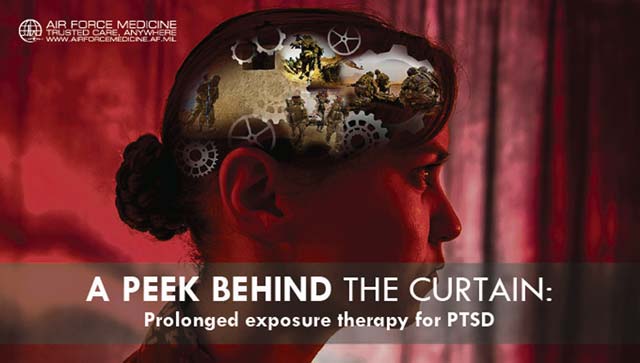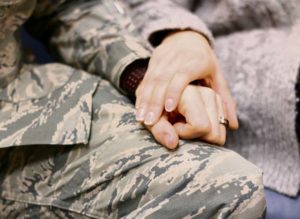
Post-traumatic stress disorder can be debilitating, but there are therapies that can reduce symptoms, improve quality of life, and help Airmen return to duty.
One of the most effective therapies, practiced by many Air Force mental health professionals, is prolonged exposure therapy.
PTSD symptoms can create a network of fear. Memories and sensations from traumatic events spill over into other parts of someone’s life. It is common for a person who has experienced trauma to try to avoid those thoughts and places that remind him or her of that traumatic event.
Lt. Col. Alicia Ottati, the Air Force Mental Health Policy chief, says symptoms can get worse the more a person avoids thoughts and places associated with the trauma.
“If a patient has PTSD related to a roadside bomb blast, they may experience increased anxiety and distress while driving or when seeing debris on the side of the road because it reminds them of that traumatic event,” said Ottati. “As a result, the person may avoid or limit driving. The unintended consequence of this avoidance may be that they rarely leave home or alter their daily schedule so they aren’t engaging with people or things that are meaningful to them, reducing their quality of life.”
The good news, says Lt. Col. Joel Foster, the Mental Health Flight commander with the 18th Medical Group at Kadena Air Force Base, Japan, is that upwards of 80 percent of patients respond favorably to prolonged exposure therapy.
“Prolonged exposure is a collaborative therapy where the goal is to safely and gradually reduce a patient’s avoidance of trauma-related memories and situations,” said Foster. “Prolonged exposure also addresses unhelpful thoughts and beliefs that may contribute to a patient’s difficulties.”

Prolonged exposure generally consists of about 10 sessions, slowly introducing the patient to the thoughts and feelings associated with the traumatic event.
As Foster explains, prolonged exposure does this through two different processes. The first is imaginal exposure, which exposes the patient to the thoughts, memories, and feelings surrounding their traumatic event. The second is in vivo exposure, which exposes the patient to places associated with the trauma.
“If someone had PTSD symptoms related to a tornado, the therapist may slowly introduce them to places they have been avoiding as a result of that tornado, such as the street where it happened,” said Foster.
Sessions involve talking through the traumatic event, which are recorded so patients can listen to them between sessions. Patients may have homework where they listen to those recordings, or go to the places they have been avoiding, while noting how they are feeling. In following sessions, the therapist will go over the homework and ask the patient to talk through the traumatic event again.
“The memories of a traumatic event is painful, but when patients start talking about the trauma, they realize these are just memories that can no longer hurt them,” said Foster. “As they repeatedly go over the trauma, it eventually takes the sting out of those memories.”
The process, called habituation, is the reason prolonged exposure therapy is effective.
“Habituation happens when you get used to a repeated stimulus,” said Foster. “Our bodies cannot remain at a high level of distress and anxiety for very long, so as we continue to talk through the traumatic event or visit a place that causes distress, eventually the body naturally calms down.”
“The goal of prolonged exposure is not to get rid of painful thoughts and feelings, but to change your relationship with and reaction to these thoughts and feelings,” said Ottati.
The important thing both Ottati and Foster want Airmen to know is that feeling nervous or anxious when starting prolonged exposure is normal, but working through the symptoms gets easier with time and practice.
“If you can put people back into the mission and have them feel effective and useful, then prolonged exposure serves as a huge benefit,” said Foster. “Prolonged exposure can give Airmen dealing with PTSD symptoms a new lease on life.”


